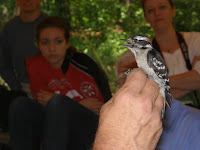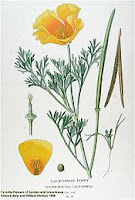 |
Can you see it? See what!....They have the nets up again!
(I think I would fly into it if I was a bird, too.
I could barely see it to take the picture. ) |
On Tuesday, May 15, 2012, I had the extreme pleasure of attending a bird banding demonstration held at the
E. L. Johnson Nature Center Bloomfield Hills Schools. The day was perfect, blue skies and mild temperatures made walking around the center enjoyable and the birds were very active. Not to mention it was right in the middle of the mating, nesting, feeding and soon to be fledgling season.
The Bird Field Research program targeted for the 4th graders of Bloomfield Hills Schools, is opened for the day to the Supporters of the E.L. Johnson Nature Center. Along with the students we all learned that records of birds sighted on the property date back to 1947. Dr. Richard Olsen, doctor, homeowner and ornithologist in his own right, started recording the birds he sighted. Since 1980's, the now E. L. Johnson Nature Center following in Dr. Olsen's footsteps started this school program and has worked with several bird banders. Since 2006, Allen Chartier has worked with the future ornithologists. Their responsibilities include:
- helping to check the nets, this is done in a timely manner so the trapped birds do not become stressed,
- banding, weighing, measuring and recording of the data of each bird.
- Releasing of the captured bird.
 |
| Allen Chartier talking to the guests |
 |
| Bird Banding equipment. |
We arrived at 11:00 a.m. and met with
Allen Chartier, Michigan Hummingbird Guy, and the other families. Allen had set up his nets and there were birds in the bags awaiting their turn to be banded. Chartier's bird banding equipment was neatly displayed, the bands, of various sizes, to fit the smallest hummingbird to the larger woodland birds awaiting the birds.
To Chartier and the students delight and surprise, one of the birds caught was an
Indigo Bunting, that was banded in 2006. What makes this even more interesting, this particular bird migrates south for the winter. Yet it has returned again for the sixth time. Being six years old is quite an accomplishment for any bird in the wild . Yet even another welcomed surprise happened during the week, not since the early 1950s has a
Alder Flycatcher or the
Orchard Oriole been spotted on the property, and this year both visited the Nature Center!
 |
| Rose Breasted Gross Beak |
 |
The rose color under the wing shows that
this is a two year old male. |
The first bird of the day was the
Rose Breasted Gross Beak. Quite a noisy fellow! A question was asked if Chartier ever gets nipped by the birds. Quick to respond, he showed us the size of the beak on the bird who feeds itself by crushing seeds, and said, "You make it look like it doesn't hurt". Chartier explained the correct way to hold the bird, he measured, weighed by placing the bird in a bag, placed the band on the leg and then recorded all the information.
After all the recording was finished, Chartier was assisted by a student to release the bird. All were cautious so not to get pecked, some intimidated, but all were pros after listening to this patient man, who one could tell dearly loves these feathered friends.
 |
Cow Bird which had a band from
the previous year. |
There were 6 birds banded during our allotted time with Chartier. 2
Downy Woodpeckers, 1 female
Red-Winged Black Bird, 1
Grackle and a
Cowbird, and the Rose Breasted Gross Beak. All were treated with respect, and this is duly noted, because a Cowbird, is a very destructive bird. These birds are not nest builders, it was originally a bird of the Plains, they followed the buffalo herds. Existing on the bugs attracted to the buffalo and its dung, they served a purpose of keeping the insect numbers in check. Because they were always on the move, the birds needed to find other ways of having their young and developed a method of laying their eggs in other bird nests along the way. Leaving the hatching, feeding and caring to an unsuspecting bird. The decline of the Buffalo herds and the loss of the open plains, forced the Cowbirds species to make changes to survive, one such change is it has moved East and into Michigan. The cowbird is one of the biggest threats, though not the only one, to Michigan's Kirkland Warbler.
There are two interesting facts that I will take away with me from this enjoyable experience:
 |
Female Red-Winged Black Bird
with Brood Patch |
- The Downy Woodpeckers, male and female have brood patches. What is a brood patch? It is an area on their under body that swells and expands and radiates heat, like a heating pad, to keep the eggs warm during incubation and the newly hatched baby birds warm also. Most species only the female has the patch as shown in the picture,
- The Downy Woodpecker is so called because of the fluffy down surrounding the base of the beak,
 |
This Downy Woodpecker had the
last word of the day.
"Become a Supporter of
the E. L. Johnson Nature Center". |



